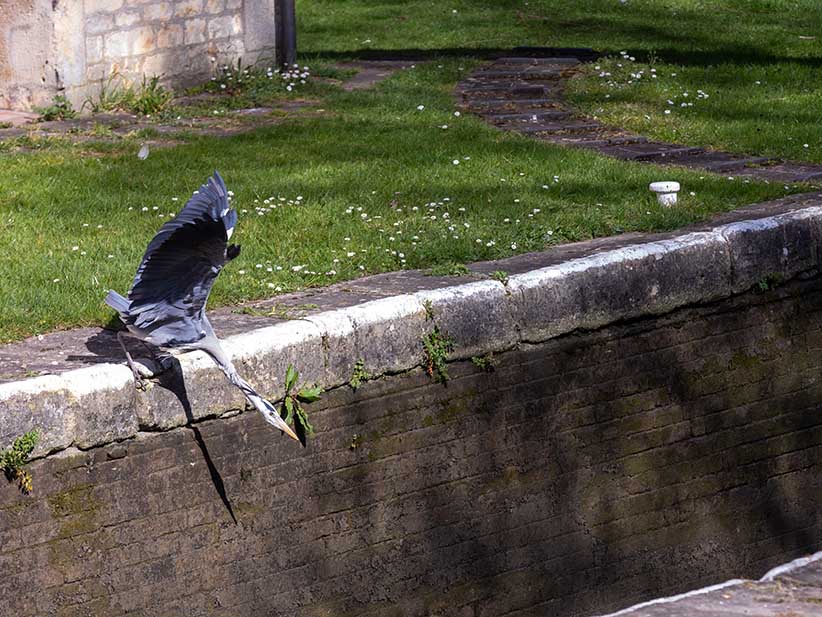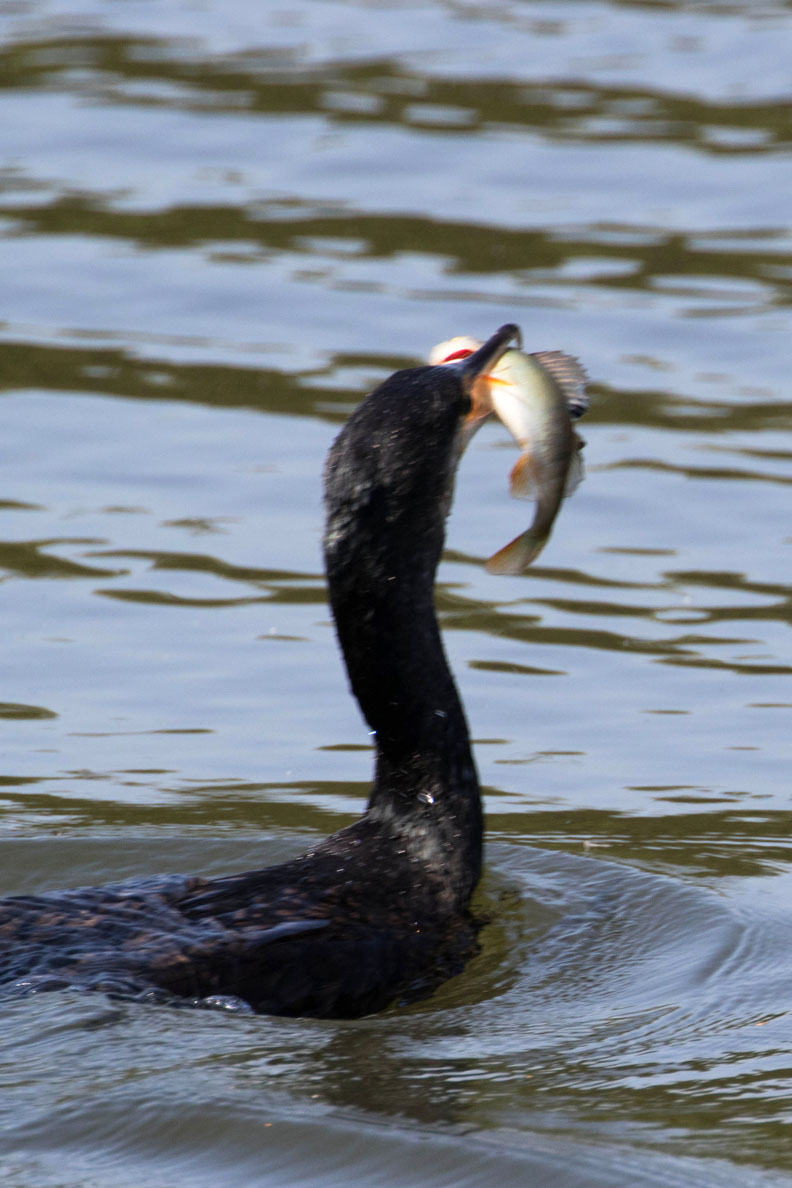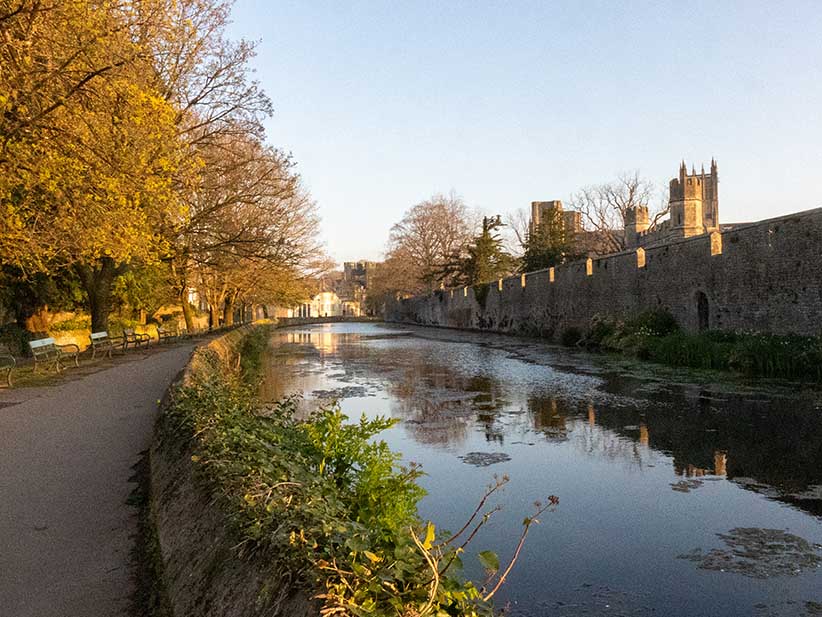The last day of March continued Britain’s unseasonal heatwave. I wandered the Kennet & Avon Canal towpath, a stone’s throw from the Georgian splendour of Bath city centre …

… to encounter nature red in tooth and claw.





(I’m pretty good at identifying British freshwater fish but this one eludes me. It sure looks one sick and sorry slice of piscine prey. I do hope Mr Heron knows what he’s doing. Contrast with this, snapped some five years ago at Nene Valley Park near Peterborough.

My focus leaves much to be desired, and it’s a different bird of aquatic prey, but Mr Cormorant’s catch is clearly a perch. What in Neptune’s name has the heron caught?)
*
I’d left steel city the previous evening, a Sunday, just after eight. Passing through Chesterfield to pick up the M1 at J29, I turned onto the A42 then M42 to skirt west then south of Birmingham for the M5 to Bristol. Around ten-thirty I pulled into the deserted car park, free and unrestricted, of Ashchurch Railway Station on the eastern edge of Tewkesbury. There I spent the night.
An hour’s drive in the morning, and I was strolling the streets of Bath with the eye of the flaneur.





The Abbey Gardens



A shapely flight of steps, you’ll agree

The telephoto lens foreshortens distance but there’s a sizable stretch of deep water above the weir and directly below the arches. Forty summers ago, on a blazing afternoon, I watched lads diving from that parapet.

Cash poor, friendship rich*
Mid afternoon and Bathed out, I caught the bus – free to seniors like me – back to Odd Down Park & Ride to fire up the van and head for Wells, Glastonbury and the Somerset Levels.







The Sweet Track – replica of a neolithic path through the marshes between Westhay and Shapwick, tree-ring dated to 3,807 BCE 1
At several hundred metres a great white egret tests the limits of my 100:400mm lens, amped up to 560mm with a 1.4 extender …


… while a barn owl at similar distance, but now with nightfall approaching, does the same in triplicate. That 1.4 extender gives me extra reach, but at cost of narrowing my widest available aperture to f/8. With shutter speed at 1/1000 seconds – on the slow side for birds in flight – I can only get the shot at ISO 20,000. ISO performance has come on tremendously, especially on mirrorless cameras like my Canon R6, but there’s digital noise in spades here.

Serious birders, like these dudes at the Avalon Hide near Shapwick, are often seen with 1,000 mm prime lenses I know cost north of £10k.


We lesser mortals cut our coats to suit our cloth. Here’s Count Dracula of Shapwick …

… here a grey wagtail at Black Hatches Weir on the Brue, a mile upstream of Glastonbury.

Actually the Brue, earmarked for a canoe trip, was disappointing. I walked its bank from West Lydford to Glastonbury and back, a round trip of fourteen miles. Deep water and high banks ruled out waders; scant tree cover likely discouraged other aquatic birds. I’d have expected to see several kingfishers on such a walk but none did I spy. Only the occasional marsh harrier, of which more in a moment, corvids, and seagulls following the ploughman.

Though a group of young swans, likely kicked out by their various parents, came through for me:


Glastonbury is Glastonbury …






Late afternoon the day before saw me driving from Shapwick to Bruton. On a narrow but busy lane I witnessed another avian kill. A female marsh harrier, her timing out by a nanosecond, ramroaded a cock pheasant. He landed in the narrow but busy lane, fluttering briefly before giving up the ghost while his killer circled the sky above.


Twenty metres on I parked at a tight tilt on a steep sloping verge. Grabbing camera from the passenger seat I leapt out to train the lens on the dead pheasant. Would the huntress swoop down to claim her kill? She would not. A passing motorist honked furiously – and unheeded – at my partially obstructing the road but still I waited. In vain. Whether spooked by my camera, the traffic, or the two corvids which showed up in record time …

… the harrier relinquished her prize. Had I not been on a rubber tramp with basic cooking only, I might have taken it. Then again, crow and magpie were ahead of me in the queue.*
*
I spent my last night in Wells, a stone’s throw from the Bishop’s Palace. No one bothered me.

Here’s the morning view.

*
Heading north for Bristol to see my daughter, I crossed a stone bridge over the delightful River Chew – which I’ll have to paddle. Maybe this summer. Parking outside Publow’s pretty church, I was approached by the man shown below. I thought he meant to tell me off but not at all. A bit of a talker, he told me that jazz clarinettist Acker Bilk, by no means a wandering stranger on the shore but born and bred here, sleeps below his home turf.

The church at Publow …

… next to the Bridge Over The River Chew.

* * *
- For a fascinating discussion of how we can gauge prehistoric time see Chapter 4 of Richard Dawkins’, The Greatest Show on Earth: the Evidence for Evolution

Phil,
Your intellectual insight is always fascinating and an important contribution to this universe. However, this place you take me from time to time makes it possible to more completely grasp the world that has shaped you. I’m thankful to have had chance to get to know both sides.
C
Your words are music to my ears, C. Thank you.